The Mobile Vascular Imaging Market is estimated to be valued at USD 1.4 billion in 2025 and is projected to reach USD 3.4 billion by 2035, registering a compound annual growth rate (CAGR) of 9.5% over the forecast period.
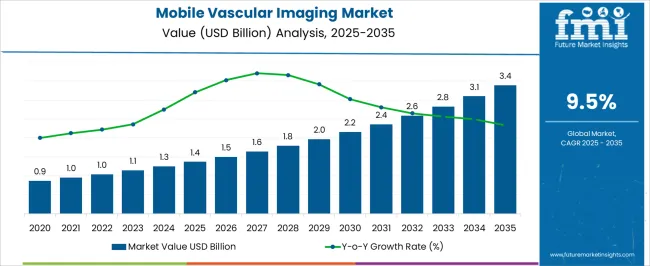
| Metric | Value |
|---|---|
| Mobile Vascular Imaging Market Estimated Value in (2025 E) | USD 1.4 billion |
| Mobile Vascular Imaging Market Forecast Value in (2035 F) | USD 3.4 billion |
| Forecast CAGR (2025 to 2035) | 9.5% |
The Mobile Vascular Imaging market is experiencing significant growth, supported by the increasing prevalence of cardiovascular disorders and the rising demand for point-of-care diagnostic solutions. The current landscape highlights strong adoption across hospitals, ambulatory care centers, and specialized clinics, where portable imaging solutions provide flexibility, rapid results, and cost savings.
Advancements in miniaturized imaging technologies, coupled with the integration of artificial intelligence for enhanced image interpretation, are fueling the shift from traditional stationary imaging systems to mobile platforms. This transformation is being reinforced by the need for real-time diagnosis in emergency care, rural healthcare outreach, and resource-constrained settings, where portability and efficiency are critical.
In addition, healthcare infrastructure investment is encouraging the adoption of advanced vascular imaging solutions that improve patient management and clinical outcomes Looking forward, the market outlook is positive as continuous innovation in imaging hardware and software is expanding the clinical utility of mobile vascular systems, while broader digital healthcare adoption is paving the way for scalable, cost-efficient deployment across diverse medical environments.
The mobile vascular imaging market is segmented by product type, application type, end user, and geographic regions. By product type, mobile vascular imaging market is divided into Ultrasound, X-ray, CT, MRI, and Nuclear Imaging System. In terms of application type, mobile vascular imaging market is classified into Diagnostic and Therapeutic. Based on end user, mobile vascular imaging market is segmented into Hospital, Ambulatory Surgical Center, and Clinic. Regionally, the mobile vascular imaging industry is classified into North America, Latin America, Western Europe, Eastern Europe, Balkan & Baltic Countries, Russia & Belarus, Central Asia, East Asia, South Asia & Pacific, and the Middle East & Africa.
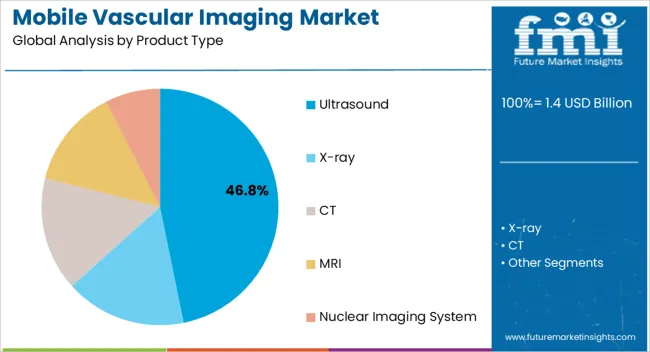
The Ultrasound segment is anticipated to account for 46.80% of the Mobile Vascular Imaging market revenue in 2025, making it the leading product type. This dominance is being attributed to the extensive use of portable ultrasound systems for vascular imaging due to their non-invasive nature, safety profile, and real-time imaging capabilities. The portability of ultrasound devices has allowed them to be integrated effectively in emergency rooms, intensive care units, and field settings where immediate vascular assessment is essential.
The segment has also grown due to advancements in high-resolution probes and software-based enhancements that enable clearer visualization of vascular structures and blood flow patterns. Cost efficiency and widespread clinical acceptance have further solidified the leadership of ultrasound in this market.
The ability to update these devices with advanced imaging algorithms through software upgrades has supported long-term adoption, while increasing awareness of early cardiovascular disease detection has strengthened demand As healthcare providers continue to prioritize accessible diagnostic solutions, ultrasound is expected to remain at the forefront of product-based growth in the sector.
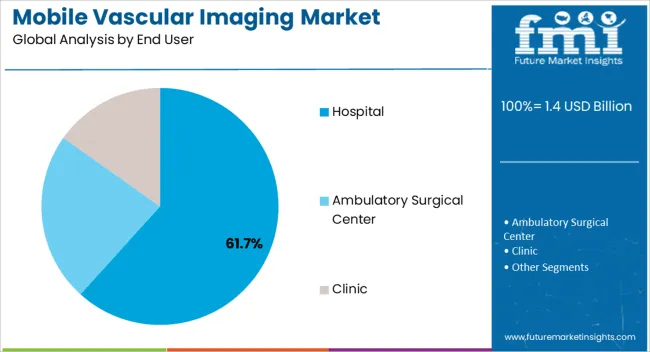
The Diagnostic application segment is projected to contribute 52.40% of the Mobile Vascular Imaging market revenue in 2025, making it the most prominent application area. This leading position is being driven by the growing reliance on portable imaging systems for the early identification and monitoring of vascular diseases such as deep vein thrombosis, arterial blockages, and aneurysms.
The use of mobile diagnostic solutions has been reinforced by their ability to provide rapid and accurate assessments that support timely treatment decisions, particularly in acute care environments. The integration of advanced software for real-time image analysis and automated measurements has enhanced diagnostic precision, making these tools indispensable in both hospital and outpatient settings.
The scalability of diagnostic imaging across primary care and rural healthcare networks has also contributed to the segment’s expansion As cardiovascular disease incidence continues to rise globally, healthcare systems are placing greater emphasis on proactive screening and monitoring, which is expected to sustain the segment’s leadership in mobile vascular imaging applications.
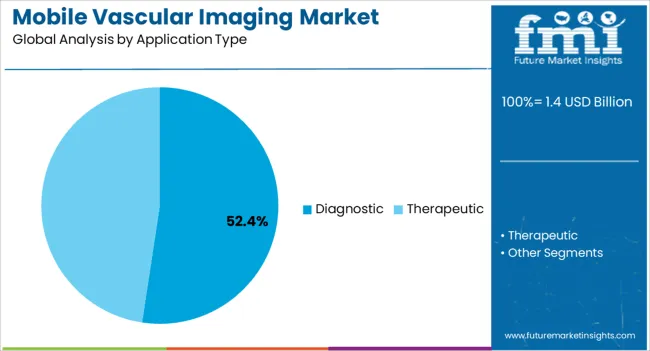
The Hospital end-user segment is expected to hold 61.70% of the Mobile Vascular Imaging market revenue in 2025, making it the dominant end-use category. This growth is being supported by the rising adoption of mobile imaging systems within hospital environments to improve patient outcomes and operational efficiency. Hospitals have increasingly deployed mobile vascular imaging devices in emergency departments, operating rooms, and critical care units, where immediate access to vascular diagnostics is essential.
The preference for hospital-based adoption has been reinforced by the ability to integrate mobile imaging systems with electronic health records, centralized monitoring platforms, and broader clinical workflows. The higher patient volumes in hospitals, coupled with increasing emphasis on advanced diagnostic capabilities, have also accelerated this trend.
Furthermore, hospitals are investing in portable systems as part of broader infrastructure modernization, driven by both clinical demand and the need for cost-efficient imaging options As healthcare delivery continues to shift toward value-based care, hospitals are expected to lead in mobile vascular imaging adoption due to their scale, infrastructure, and ability to leverage advanced technologies for comprehensive vascular assessment.
Vascular treatments are having an evolution of its own, as the procedure counts are increasing on a year basis. Mobile vascular imaging devices are one step ahead of the traditional standalone devices, being a movable modality it is highly recommended in places where infrastructure does not allow any fixed capital equipment. There are many mobile vascular imaging devices available in the current market for general practice like mobile C-arms which are mostly used in modern endovascular practices. There are possible departments present in any healthcare facilities which requires mobile devices for carrying any set of imaging diagnosis like CATH lab and intensive care units. There are leading providers of mobile vascular imaging devices involved in the market presenting technological advanced products with consumer preference.
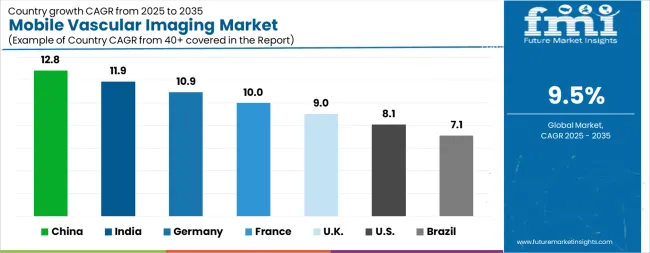
| Country | CAGR |
|---|---|
| China | 12.8% |
| India | 11.9% |
| Germany | 10.9% |
| France | 10.0% |
| UK | 9.0% |
| USA | 8.1% |
| Brazil | 7.1% |
The Mobile Vascular Imaging Market is expected to register a CAGR of 9.5% during the forecast period, exhibiting varied country level momentum. China leads with the highest CAGR of 12.8%, followed by India at 11.9%. Developed markets such as Germany, France, and the UK continue to expand steadily, while the USA is likely to grow at consistent rates.
Brazil posts the lowest CAGR at 7.1%, yet still underscores a broadly positive trajectory for the global Mobile Vascular Imaging Market. In 2024, Germany held a dominant revenue in the Western Europe market and is expected to grow with a CAGR of 10.9%.
The USA Mobile Vascular Imaging Market is estimated to be valued at USD 478.4 million in 2025 and is anticipated to reach a valuation of USD 1.0 billion by 2035. Sales are projected to rise at a CAGR of 8.1% over the forecast period between 2025 and 2035. While Japan and South Korea markets are estimated to be valued at USD 65.4 million and USD 34.9 million respectively in 2025.
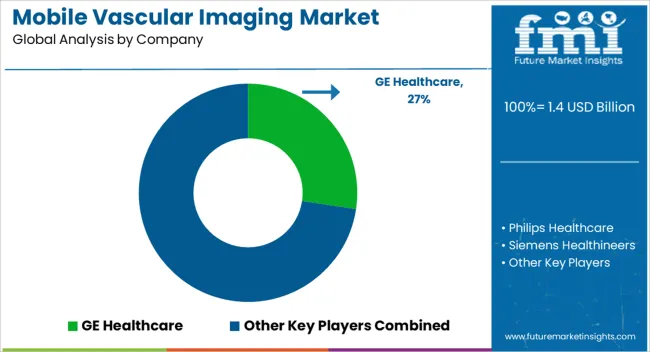
| Item | Value |
|---|---|
| Quantitative Units | USD 1.4 Billion |
| Product Type | Ultrasound, X-ray, CT, MRI, and Nuclear Imaging System |
| Application Type | Diagnostic and Therapeutic |
| End User | Hospital, Ambulatory Surgical Center, and Clinic |
| Regions Covered | North America, Europe, Asia-Pacific, Latin America, Middle East & Africa |
| Country Covered | United States, Canada, Germany, France, United Kingdom, China, Japan, India, Brazil, South Africa |
| Key Companies Profiled | GE Healthcare, Philips Healthcare, Siemens Healthineers, Ziehm Imaging, Shimadzu, Omega Medical Imaging LLC., Mindray Medical International Ltd., and Hitachi |
The global mobile vascular imaging market is estimated to be valued at USD 1.4 billion in 2025.
The market size for the mobile vascular imaging market is projected to reach USD 3.4 billion by 2035.
The mobile vascular imaging market is expected to grow at a 9.5% CAGR between 2025 and 2035.
The key product types in mobile vascular imaging market are ultrasound, x-ray, ct, MRI and nuclear imaging system.
In terms of application type, diagnostic segment to command 52.4% share in the mobile vascular imaging market in 2025.






Our Research Products

The "Full Research Suite" delivers actionable market intel, deep dives on markets or technologies, so clients act faster, cut risk, and unlock growth.

The Leaderboard benchmarks and ranks top vendors, classifying them as Established Leaders, Leading Challengers, or Disruptors & Challengers.

Locates where complements amplify value and substitutes erode it, forecasting net impact by horizon

We deliver granular, decision-grade intel: market sizing, 5-year forecasts, pricing, adoption, usage, revenue, and operational KPIs—plus competitor tracking, regulation, and value chains—across 60 countries broadly.

Spot the shifts before they hit your P&L. We track inflection points, adoption curves, pricing moves, and ecosystem plays to show where demand is heading, why it is changing, and what to do next across high-growth markets and disruptive tech

Real-time reads of user behavior. We track shifting priorities, perceptions of today’s and next-gen services, and provider experience, then pace how fast tech moves from trial to adoption, blending buyer, consumer, and channel inputs with social signals (#WhySwitch, #UX).

Partner with our analyst team to build a custom report designed around your business priorities. From analysing market trends to assessing competitors or crafting bespoke datasets, we tailor insights to your needs.
Supplier Intelligence
Discovery & Profiling
Capacity & Footprint
Performance & Risk
Compliance & Governance
Commercial Readiness
Who Supplies Whom
Scorecards & Shortlists
Playbooks & Docs
Category Intelligence
Definition & Scope
Demand & Use Cases
Cost Drivers
Market Structure
Supply Chain Map
Trade & Policy
Operating Norms
Deliverables
Buyer Intelligence
Account Basics
Spend & Scope
Procurement Model
Vendor Requirements
Terms & Policies
Entry Strategy
Pain Points & Triggers
Outputs
Pricing Analysis
Benchmarks
Trends
Should-Cost
Indexation
Landed Cost
Commercial Terms
Deliverables
Brand Analysis
Positioning & Value Prop
Share & Presence
Customer Evidence
Go-to-Market
Digital & Reputation
Compliance & Trust
KPIs & Gaps
Outputs
Full Research Suite comprises of:
Market outlook & trends analysis
Interviews & case studies
Strategic recommendations
Vendor profiles & capabilities analysis
5-year forecasts
8 regions and 60+ country-level data splits
Market segment data splits
12 months of continuous data updates
DELIVERED AS:
PDF EXCEL ONLINE
Vascular Imaging Systems Market Growth - Trends & Forecast 2025 to 2035
Intravascular Imaging Market Growth – Trends & Forecast 2025 to 2035
Spectroscopy Intravascular Imaging System Market
Mobile Camping Toilet Market Size and Share Forecast Outlook 2025 to 2035
Mobile Phone Screen Underlayer Cushioning Material Market Size and Share Forecast Outlook 2025 to 2035
Vascular Sheath Group Market Size and Share Forecast Outlook 2025 to 2035
Mobile Application Store Market Size and Share Forecast Outlook 2025 to 2035
Vascular Patches Market Forecast and Outlook 2025 to 2035
Vascular Access System Market Size and Share Forecast Outlook 2025 to 2035
Mobile Money Market Forecast and Outlook 2025 to 2035
Mobile Application Testing Solution Market Size and Share Forecast Outlook 2025 to 2035
Mobile Cardiac Telemetry System Market Size and Share Forecast Outlook 2025 to 2035
Mobile Robots Market Size and Share Forecast Outlook 2025 to 2035
Mobile Crane Market Size and Share Forecast Outlook 2025 to 2035
Mobile Animal Inhalation Anesthesia Machine Market Size and Share Forecast Outlook 2025 to 2035
Mobile Unified Communications and Collaboration (UC&C) Solution Market Size and Share Forecast Outlook 2025 to 2035
Mobile Data Protection Market Size and Share Forecast Outlook 2025 to 2035
Mobile Medical Tablets Market Size and Share Forecast Outlook 2025 to 2035
Mobile WLAN Access Points Market Size and Share Forecast Outlook 2025 to 2035
Mobile Social Networks Market Size and Share Forecast Outlook 2025 to 2035

Thank you!
You will receive an email from our Business Development Manager. Please be sure to check your SPAM/JUNK folder too.
Chat With
MaRIA